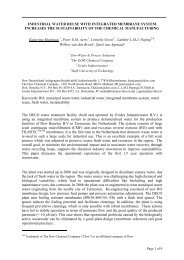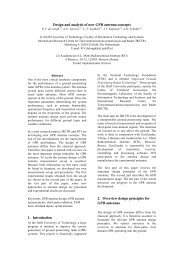CT4860 STRUCTURAL DESIGN OF PAVEMENTS
CT4860 STRUCTURAL DESIGN OF PAVEMENTS
CT4860 STRUCTURAL DESIGN OF PAVEMENTS
Create successful ePaper yourself
Turn your PDF publications into a flip-book with our unique Google optimized e-Paper software.
3.4.3 Load transfer in joints/cracks<br />
In 3.4.2 equations and charts have been given for the calculation of flexural<br />
tensile stresses and deflections due to traffic loadings in a single concrete<br />
slab. However, in reality a concrete pavement consists of a number of<br />
concrete slabs with joints (plain concrete pavements) or cracks (reinforced<br />
concrete pavements) between them. The load transfer in these joints and<br />
cracks is dependent on the joint or crack width (which depends on the slab<br />
length), the amount of traffic and the type of joint or crack construction, which<br />
means: aggregate interlock, reinforcement, ty bars and dowel bars.<br />
First the last mentioned four influence factors will be discussed separately and<br />
then the total load transfer in the joint or crack (i.e. the joint or crack<br />
efficiency).<br />
Aggregate interlock is the phenomenon that both rough sides of a joint or<br />
crack stick into each other. The load transfer due to aggregate interlock is<br />
dependent on:<br />
a. the joint or crack width: the greater this width, the lower the load transfer<br />
b. the effective thickness of the concrete layer (= total thickness minus the<br />
depth of the saw cut for a contraction joint): the greater this thickness, the<br />
higher the load transfer<br />
c. the rate of support of the concrete layer by the substructure: the higher the<br />
modulus of substructure reaction k, the smaller the deflections w of the<br />
slab edges due to traffic loadings P (see equations 47 and 49), the lower<br />
the shear forces at the joint or crack sides, the lower the polishing of the<br />
concrete, and thus the higher the load transfer<br />
d. the magnitude of the traffic loadings: the deflections of the slab edges are<br />
proportional to the magnitude P of the traffic loadings (see equations 28<br />
and 30), and therefore the smaller the traffic loadings, the higher the load<br />
transfer (similar to c)<br />
e. the aggregate shape in the concrete mixture: the more rough (the higher<br />
the angle of internal friction) the aggregate, the higher the load transfer.<br />
Both the amount and the diameter of ty bars in longitudinal joints of plain<br />
concrete pavements are such small, that they will not have any significant<br />
direct influence on the load transfer. However, indirectly they have a<br />
considerable effect because due to the ty bars the joint width is very limited<br />
and therefore the load transfer by means of aggregate interlock will be<br />
maintained.<br />
For the reinforcement in reinforced concrete pavements the same applies as<br />
for ty bars.<br />
The amount and diameter of dowel bars in contraction joints of plain concrete<br />
pavements are such that they yield a considerable load transfer. Load transfer<br />
by means of dowel bars mainly occurs by shear forces rather than by bending<br />
forces. The stiffness Sd of one single dowel bar is defined as (18):<br />
40











